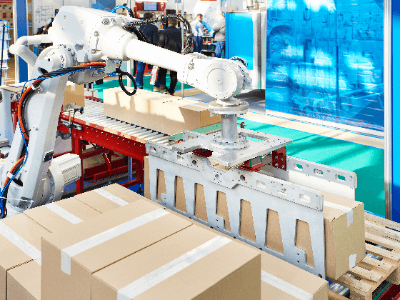What Is a Palletizing Robot?

A palletizing robot is an industrial robot that stacks boxes packed with products in a predetermined position on a pallet.
It is sometimes also called a palletizer. Palletizing robots feature a highly automated robot arm that handles the task of transporting and loading heavy loads. Because of its many advantages, such as enabling high-mix low-volume production, improving food product freshness, and reducing shipping time, palletizing robots are attracting attention in a variety of industries.
A similar type of equipment is the depalletizing robot, which automatically unloads boxes mounted on pallets. Depalletizing robots have similar benefits.
Applications of Palletizing Robots
Palletizing robots are used in a wide range of industries, including many manufacturing and logistics industries that handle food, chemical, and machine parts. In manufacturing and logistics, boxes packed with products are stacked in specific arrangements on pallets, and then lifted by forklifts to efficiently transport the pallets.
Manually lifting boxes one by one after packing and stacking them on pallets in multiple layers is extremely burdensome work. Onsite, the risk of back pain is a major problem.
By introducing palletizing robots, the work of loading pallets can be automated, which is expected to save labor, reduce the risk of work-related injuries, and streamline the production process.
Principle of Palletizing Robots
Palletizing Robot has a gripping mechanism that grips the box in which the product is packed and an arm to which the gripping mechanism is attached. If the processes before and after the palletizing robot are also automated to some extent, the position of the pallet can be the same every time as the position of the boxes sent from the previous process.
Therefore, if the robot repeatedly performs the pre-teached grasping, carrying, and loading operations, it can load the boxes at the exact position. One side of the jaws that make up the gripping mechanism is thinner than the other side, allowing adjacent boxes to be loaded in close contact. Safety principles are specified to prevent workers from entering the robot’s range of motion, since workers may be injured if the robot arm collides with them.
Therefore, in addition to automation of product transfer from the previous process using conveyor belts, etc., worker safety is ensured by installing fences to prevent entry into the robot’s movable range and by installing ancillary equipment such as doors with interlocks that stop operation when opened.
Types of Palletizing Robots
Palletizing robots include vertically articulated robots and Cartesian coordinate robots.
1. Vertically Articulated Robots
Vertically articulated robots have a structure similar to a human arm. Vertically articulated palletizing robots, for example, consist of 4, 5 or 6 axes.
2. Cartesian Robots
An orthogonal robot is a robot with a simple structure consisting of a single-axis linear motion unit. An orthogonal palletizing robot consists of 3 or 4 axes, for example.
Other Information on Palletizing Robots
1. Teaching Palletizing Robot
Palletizing robots performs the task of repositioning an item from its initial position to a specific position. For example, if the Palletizing Robot performs the task of placing a pallet of 30 boxes (30 long x 20 wide) on a pallet, a total of 600 boxes will be loaded on the pallet.
If we assume that we need to define 5 teaching points for the palletizing robot to reposition one box, then to program this palletizing operation, we need to teach 600 x 5 = 3,000 positional information to the palletizing robot. The palletizing robot must be taught 3,000 positional information.
Teaching 3,000 position data manually to the palletizing robot is a very difficult task. Therefore, teaching is generally simplified by taking advantage of the features of palletizing.
In the case of a pallet with 30 boxes lined up in a regular pattern (30 boxes vertically and 20 boxes horizontally), if the positional relationship of adjacent boxes is known, the positions of all boxes can be calculated by offsetting them by the difference of their positions. Teaching the robot the calculated positions of all the boxes completes the robot teaching.
2. Difference from Depalletizing
Depalletizing is the process of moving goods on a pallet to a predetermined position. In other words, it is the reverse of palletizing. Since palletizing and depalletizing involve almost the same work, similar robots can be used.
Depalletizing is part of the process of transporting goods delivered by an outside manufacturer to various locations within the company. Because the palletizing of goods is done externally, it can be difficult to maintain a certain level of palletizing accuracy quality. In this case, it is generally more difficult to develop a depalletizing process than to develop a palletizing process because it may not be possible to accurately perform the depalletizing operation within the company.